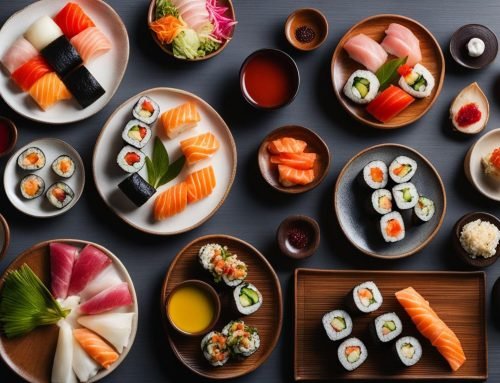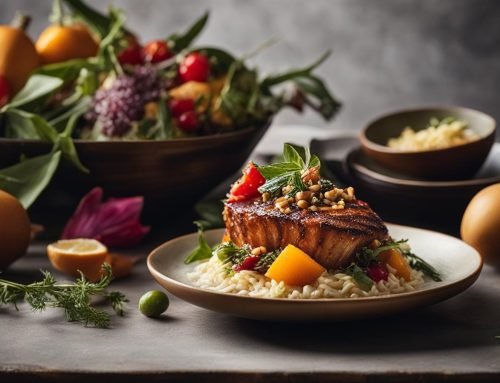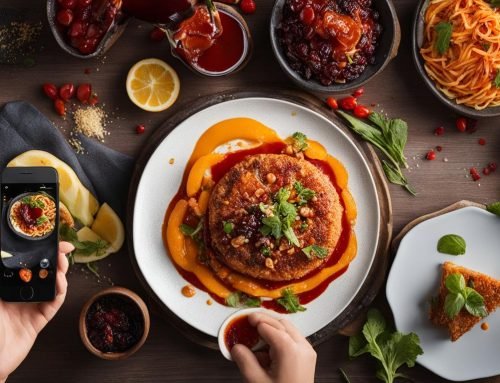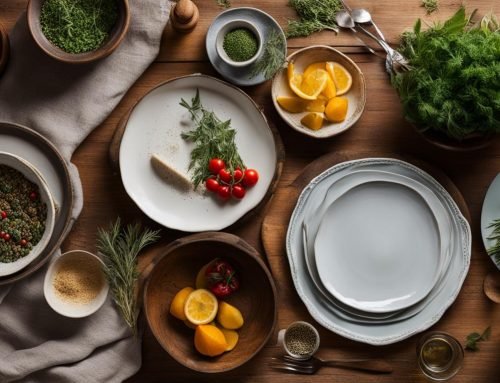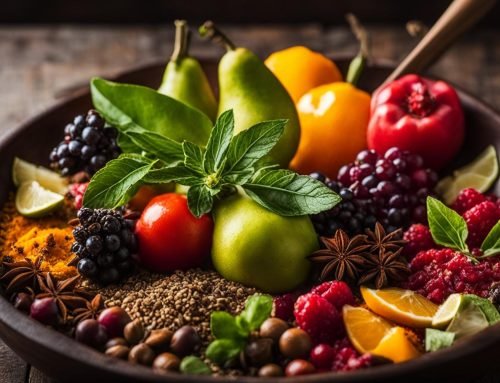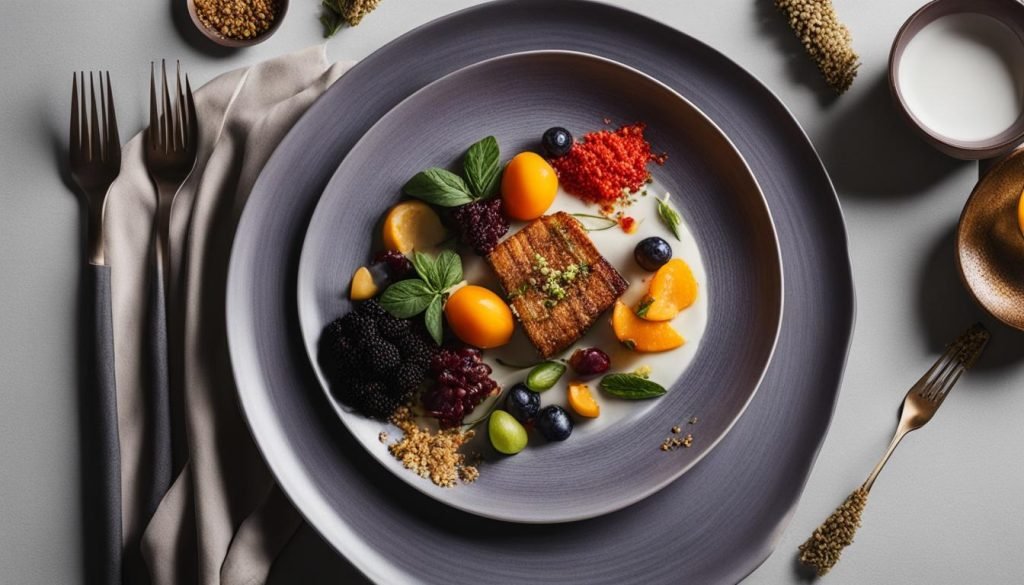
Food styling is the art and science of presenting food in a visually appealing manner. It transforms ordinary meals into extraordinary visual feasts. In this comprehensive guide, we will provide you with expert tips and techniques to master the craft of food styling. Whether you are a beginner or an experienced food stylist, these tips will help you unleash your creativity in the kitchen and create culinary creations that are a visual delight. We will cover everything from plate composition to colors and textures, props and accessories, food styling techniques, and tips for food styling success.
Key Takeaways:
- Learn the art of food styling to transform your meals into visually stunning dishes.
- Explore expert tips and techniques for plate composition, colors, textures, and props.
- Unleash your creativity and enhance your food presentation skills.
- Master the craft of food styling with practical advice and inspiration.
- Create visually appealing dishes that leave a lasting impression.
The Basics of Plate Composition in Food Styling
Plate composition is a crucial aspect of food styling. The way you choose and arrange food on a plate can make all the difference in creating a visually appealing dish. First and foremost, it’s important to select the right plate. Opt for white or lightly colored plates that provide a neutral background, allowing the food to take center stage. The size and shape of the plate should also be considered, depending on the dish you’re styling.
When it comes to arranging the food, balance is key. Consider placing different elements on the plate and strive for a harmonious composition. Consider layering textures to add depth and dimension to your dish. For example, you can pair creamy sauces with crispy vegetables or tender meats with crunchy garnishes. Keep in mind that overcrowding the plate can detract from the presentation, so give each component enough space to shine.
Remember, plate composition aims to create a visually appealing and inviting dish. By choosing the right plate and arranging the food thoughtfully, you can enhance the overall aesthetic of your culinary creation.
Creating Visual Interest with Colors and Textures in Food Styling
When it comes to food styling, colors and textures are key elements that can take your dishes from ordinary to extraordinary. Choosing the right colors and textures can create visual interest and make your culinary creations truly stand out. You can add depth, dimension, and excitement to your dishes by combining different colors and textures.
When selecting colors, consider using a mix of complementary and contrasting hues. Complementary colors, such as blue and orange or red and green, can create a harmonious and pleasing visual effect. Contrasting colors, like yellow and purple or pink and green, can add a vibrant and energetic look to your dish.
“Colors and textures play a crucial role in creating visually stunning and appealing dishes in food styling. Adding a variety of hues and textures to a dish brings it to life.” – Food Styling Expert
Textures are also important in food styling, providing sensory appeal and adding visual interest. Mixing smooth and creamy textures with crunchy and crispy ones can create a delightful contrast that engages both the eyes and the palate. Consider adding toppings, garnishes, or side dishes that offer different textures to your main dish.
Choosing the Right Colors and Textures
- Experiment with complementary and contrasting colors to create visual interest.
- Play with textures by combining smooth and crunchy elements.
- Consider the overall theme and mood of your dish when selecting colors and textures.
By carefully choosing colors and textures, you can elevate your food styling to the next level and create visually stunning dishes that are a feast for the eyes.
Elevating Your Food Styling with Props and Accessories
Props and accessories are essential elements in food styling that can take your culinary creations to the next level. They add depth, context, and visual interest to your dishes, elevating the overall presentation. When choosing props and accessories, it’s crucial to select ones that enhance the theme or style of your dish, creating a cohesive and harmonious composition.
Consider the following tips to choose the right props and accessories for your food styling:
- Complement the theme: Select props and accessories that align with the overall theme or concept of your dish. For example, if you’re styling a rustic farm-to-table dish, wooden cutting boards or vintage mason jars can add a touch of authenticity.
- Avoid distractions: Use props sparingly to avoid overpowering the dish. The focus should always be on the food itself. Choose props that enhance the presentation without stealing the spotlight.
- Pay attention to colors and textures: Props can contribute to the overall visual appeal by adding contrast or harmony to the composition. Consider how the colors and textures of your props interact with the colors and textures of the food.
Remember, the goal of props and accessories is to enhance the storytelling aspect of your dish. They should create a visual narrative that complements the flavors and presentation of the food. By using props effectively, you can create visually captivating dishes that leave a lasting impression on your viewers.
Conclusion
Food styling is a creative and precise art form that allows you to transform ordinary meals into visually stunning and appetizing dishes. Mastering the techniques and tips discussed in this comprehensive guide can unleash your creativity and captivate viewers with your culinary creations.
From plate composition to colors and textures, props and accessories, and food styling techniques, there are endless possibilities to explore in food styling. Whether you are a professional food stylist or an amateur chef looking to enhance your food presentation, these expert tips will help you take your skills to the next level.
So get ready to create visually delightful dishes that will leave a lasting impression. Elevate your food styling with your newfound knowledge and showcase your culinary talents through captivating food photography. Experiment with food composition, master the art of food plating, and explore new ways to present and arrange your dishes. With these food styling ideas, you can bring your culinary visions to life and leave your audience craving more.
FAQ
What is food styling?
Food styling is the art and science of presenting food in a visually appealing manner.
How can food styling transform ordinary meals?
Food styling can transform ordinary meals into extraordinary visual feasts.
Who can benefit from these food styling tips?
These food styling tips are helpful for both beginners and experienced food stylists.
What does plate composition involve?
Plate composition involves choosing the right plate and arranging the food in a visually appealing manner.
What role do colors and textures play in food styling?
Colors and textures play a crucial role in creating visually stunning and appealing dishes in food styling.
How can props and accessories enhance food styling?
Props and accessories add context, depth, and visual interest to the overall presentation of the dish.
What can I learn from this comprehensive guide on food styling?
This guide covers everything from plate composition to colors and textures, props and accessories, and food styling techniques, providing valuable insights and tips for food styling success.

